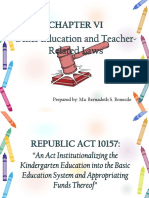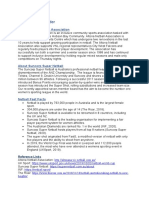Beach Volleyball Rules PDF
Beach Volleyball Rules PDF
Uploaded by
maria3180Copyright:
Available Formats
Beach Volleyball Rules PDF
Beach Volleyball Rules PDF
Uploaded by
maria3180Original Description:
Original Title
Copyright
Available Formats
Share this document
Did you find this document useful?
Is this content inappropriate?
Copyright:
Available Formats
Beach Volleyball Rules PDF
Beach Volleyball Rules PDF
Uploaded by
maria3180Copyright:
Available Formats
Volleyball with Heart Tournament Rules
WAIVERS In order to participate, each participant must sign the waiver at registration.
ABC STAFF There will be ABC Members available to help with any questions regarding courts, rules and schedules. If you have any questions please ask. REFEREES There will be volunteer refs at each court to help with keeping score as well as questions regarding the rules. The ref at the court will have the final say in any dispute. SPORTSMANSHIP The idea of this day is to have fun and to raise money for a great cause. Please keep this in mind throughout the day. You can still be competitive and maintain good sportsmanship at the same time. If there is any behavior that is unsportsmanlike that player will be asked to leave.
TOURNAMENT PLAY This will be a double elimination tournament. Each match will consist of 1 game using rally score (every point counts) up to 25 or highest score at the end of the 30 minute time limit. Ties will be decided by the next point. If your team is not on the court in at least 5 minutes after the start time it will be an automatic forfeit.
NUMBER OF PLAYERS The maximum number of players on the court is 6. There is no maximum to the number of players on your team. The minimum number of players is 5 and there are no gender requirements. SERVICE POSSESSION A team earns service possession for the start of the first game by winning a Rock/Paper/Scissors. ROTATION Team members must rotate on the court and must remain in that po sition until the serve has been contacted. The player in the back right hand corner of the rotation will be designated to serve and continue to rotate clockwise. PLAYING THE BALL LET SERVES - Serves that hit the net and go over the net to the opponents side will be "live" and are good serves provided they are played by the opposing team or they land in bounds. THREE CONTACTS - Each team is allowed a maximum of 3 successive contacts of the ball in order to return the ball to the opponent's area. (Exception: In the action of blocking an attacking ball, the touch, or contact resulting from the block attempt does not constitute one of the three successive contacts.) ATTACKING THE NET- Only the three players that are in the front row of the rotation are allowed to attack the net. Violation of this rule would include any hitting or blocking that occurs above the plane of the net. SIMULTANEOUS CONTACTS - When two non-blocking teammates touch the ball simultaneously, it is considered one contact, and any player may make the next contact. When two blocking teammates touch the ball simultaneously, it is not counted as a contact, and any player may make the next contact. -When two opponents simultaneously and instantaneously contact the ball over the net, the ball remains in play and the team receiving the ball is entitled to another three hits. If such a ball lands out, it is the fault of the team on the opp osite side of the net from where the ball lands. CHARACTERISTICS OF THE CONTACT - The ball can contact any number of body parts down to, and including the foot, providing such contacts are simultaneous and the ball rebounds immediately and cleanly after such contact. HELD BALL - The ball must be contacted cleanly and not held, lifted, pushed, caught, carried or thrown. The ball cannot
roll or come to rest on any part of a players body. It can rebound in any direction. HAND SETS - A contact of the ball using the fingers of one or two hands to direct the ball toward a teammate is a set. The ball must come into contact with both hands simultaneously and leave both hands simultaneously to avoid a double hit call. A player may set the ball over the net in front or behind them only in the direction in which their shoulders are squarely facing. Rotation of the ball after the set may indicate a held ball or multiple contacts during the set but in itself IS NOT A FAULT. Setting the serve is legal. ATTACKING THE BALL OVER THE OPPONENTS COURT- A player is not allowed to attack the ball on the opposite side of the net. If the ball is hit above the spikers side of the net and then the follow -through causes the spiker's hand and arm to cross the net without contacting an opponent or the net, the action does not constitute a fault. BLOCKING Blocking is the action close to the net which intercepts the ball coming from the opponents side by making contact with th e ball before, during or after it crosses the net. MULTIPLE CONTACTS - Multiple contacts of the ball by a player(s) participating in a block shall be legal provided it is during one attempt to intercept the ball. Multiple contacts of the ball during a block shall be not be counted as a contact, even though the ball may make multiple contacts with one or more players of the block. PARTICIPATION AFTER A BLOCK - Any player participating in a block shall have the right to make the next contact, such contact counting as the first of three hits allowed the team. BLOCKING A SERVE - Blocking or attacking a serve is prohibited. BLOCKING A BALL ACROSS THE NET - Blocking of the ball across the net above the opponent's court shall be legal provided that such a block is: (1) After a player of the attacking team has spiked the ball, or, in the referee's judgment, intentionally directed the ball into the opponent's court, or has exhausted their third allowable hit. (2) After the opponents have hit the ball in such a manner that the ball would clearly cross the net if not touched b y a player, provided no member of the attacking team is in a position to make a legal play on the ball (3) If the ball is falling near the net and no member of the attacking team could reasonably make a play on the ball. PLAY AT THE NET PLAYER CONTACT WITH THE NET - No part of the body may touch the net at any time unless a ball or person driven into the net causes the contact. Player contact with the net in a manner not directly relating to or affecting the course of play is not a violation. Contact with hair or part of the uniform will not be considered a fault. SIMULTANEOUS CONTACT BY OPPONENTS - If opponents contact the net simultaneously, it shall constitute a double fault and the point shall be played over. INTERFERENCE - Beach volleyball allows any and all parts of the body to cross the center line as long as there is no interference with the opposing player.
You might also like
- Zeros Are Not PermittedDocument4 pagesZeros Are Not PermittedMichael KingNo ratings yet
- Pre-Shock Wee 1: Vert Shock Shock PhaseDocument12 pagesPre-Shock Wee 1: Vert Shock Shock PhaseTomás TavaresNo ratings yet
- Occupational Health and Safety ProceduresDocument11 pagesOccupational Health and Safety ProceduresLyca Den Dew100% (1)
- Employee Relations Work Life BalanceDocument10 pagesEmployee Relations Work Life Balancejrjwdavis28No ratings yet
- Richard Ulm - Curriculum VitaeDocument6 pagesRichard Ulm - Curriculum Vitaejaredshoe27No ratings yet
- C1 Intro Food IngredientsDocument44 pagesC1 Intro Food IngredientsSyeeraNo ratings yet
- FIBA Rules Changes From 1 10 2022 v1 0a enDocument27 pagesFIBA Rules Changes From 1 10 2022 v1 0a enMaybelle Aggabao100% (1)
- Regular and Irregular Concave and Convex PolygonsDocument15 pagesRegular and Irregular Concave and Convex Polygonsapi-602804696No ratings yet
- Resolution High School Week 2022Document5 pagesResolution High School Week 2022larry delos reye100% (1)
- KS3 G7 ADM Q4 Module1-9-For-PrintingDocument40 pagesKS3 G7 ADM Q4 Module1-9-For-PrintingMichelle LaurenteNo ratings yet
- Grabe Ka FinalDocument57 pagesGrabe Ka FinalJoanne Bernadette AguilarNo ratings yet
- Final LRPDocument45 pagesFinal LRPOnelazy20 TVNo ratings yet
- 2nd Periodical ExamDocument4 pages2nd Periodical ExamLourie Jean Tupaz TelinNo ratings yet
- 1 - Introduction To MNCHN EINC - 14june2012Document25 pages1 - Introduction To MNCHN EINC - 14june2012DoyTanNo ratings yet
- EarthDocument20 pagesEarthShiela Mae RegualosNo ratings yet
- Aquaculture Final Paper 1Document15 pagesAquaculture Final Paper 1api-440388115No ratings yet
- Sample Recruitment Policy LockedDocument3 pagesSample Recruitment Policy LockedSurya KartheekNo ratings yet
- Criminal Law Sample QuizDocument1 pageCriminal Law Sample QuizJo Bats100% (1)
- (Appendix 7) FAQs On Alternative Classroom ObservationDocument2 pages(Appendix 7) FAQs On Alternative Classroom ObservationRodelMinianoNo ratings yet
- Lesson 6: News Writing and ReportingDocument56 pagesLesson 6: News Writing and ReportingEmon Mijas0% (1)
- ICT Best PracticesDocument50 pagesICT Best PracticesJayvan0% (1)
- Cues Nursing Diagnosis Analysis Goals & Objectives Nursing Interventions Rationale Evaluation Subjective: Immediate Cause: GoalDocument3 pagesCues Nursing Diagnosis Analysis Goals & Objectives Nursing Interventions Rationale Evaluation Subjective: Immediate Cause: GoalGelizen GuinocanNo ratings yet
- Hydrometeorological HazardDocument5 pagesHydrometeorological HazardMddL KnGNo ratings yet
- Case Study For NCMP 112Document3 pagesCase Study For NCMP 112Renie Serrano100% (1)
- Contraceptive MethodDocument17 pagesContraceptive MethodKarina Puspita SariNo ratings yet
- 2nd Quarter Science 7Document18 pages2nd Quarter Science 7April Joy Yares SiababaNo ratings yet
- Questionnaire COVID 19 PANDEMIC CHALLENGES AND PERCEIVED MENTAL HEALTH WORKERS OF LGU IBA ZAMBALES BASIS FOR INTERVENTION SCHEMEDocument5 pagesQuestionnaire COVID 19 PANDEMIC CHALLENGES AND PERCEIVED MENTAL HEALTH WORKERS OF LGU IBA ZAMBALES BASIS FOR INTERVENTION SCHEMEIndustrial TechnologyNo ratings yet
- Lesson Plan Biotic and AbioticDocument3 pagesLesson Plan Biotic and AbioticsharyNo ratings yet
- Activity 1A MicroscopeDocument4 pagesActivity 1A MicroscopeClarito ManaayNo ratings yet
- NCM 105 - Elderhood NutritionDocument2 pagesNCM 105 - Elderhood NutritionCrisheila Sarah Piedad100% (1)
- Stages of Human DevelopmentDocument6 pagesStages of Human DevelopmentnewbienurseNo ratings yet
- Grade 7 Chapter 1: Number SenseDocument33 pagesGrade 7 Chapter 1: Number SensebozicaNo ratings yet
- 3 Fold Brochure TemplateDocument3 pages3 Fold Brochure TemplatetburkleNo ratings yet
- Moon Phases and EclipsesDocument2 pagesMoon Phases and Eclipsesapi-356714607No ratings yet
- PM Testbank Chap 10Document9 pagesPM Testbank Chap 10GabrielMichaelMalubayCapuyanNo ratings yet
- Light by AndrewDocument21 pagesLight by AndrewAndrew gadNo ratings yet
- A Mobile Application For Academic Collaborative LearningDocument57 pagesA Mobile Application For Academic Collaborative LearningZaynab B. ANo ratings yet
- TESDA MuntiParLas - Handwash MakingDocument37 pagesTESDA MuntiParLas - Handwash MakingPaulo Tiangco100% (1)
- Module 2.stating - ProblemDocument10 pagesModule 2.stating - ProblemSaheli MukherjeeNo ratings yet
- Horizontal Projectile Motion: Objective: Predict Where Your Ball Will Land!Document2 pagesHorizontal Projectile Motion: Objective: Predict Where Your Ball Will Land!Leznan DayNo ratings yet
- Practice Occupational Health and Safety ProceduresDocument25 pagesPractice Occupational Health and Safety ProceduresJuzielou ResareNo ratings yet
- Lab 1: The Microscope (10 Points) : Exercise 1.1: Microscope Structure and FunctionDocument12 pagesLab 1: The Microscope (10 Points) : Exercise 1.1: Microscope Structure and Functionrashmi_harryNo ratings yet
- 7E Model of LearningDocument10 pages7E Model of LearningEnan LimNo ratings yet
- Taenia Saginata and Taenia Solium Common NameDocument2 pagesTaenia Saginata and Taenia Solium Common NamePrabin ShakyaNo ratings yet
- DEfining & Identifying Variables G7Document24 pagesDEfining & Identifying Variables G7AnnRubyAlcaideBlandoNo ratings yet
- Time SeriesDocument61 pagesTime SeriesMigz labianoNo ratings yet
- Dr. Amelia A. Biglete Ceso IiiDocument4 pagesDr. Amelia A. Biglete Ceso IiiAntazo JemuelNo ratings yet
- Cos The Law of ReflectionDocument10 pagesCos The Law of ReflectionGiancarlo SantosNo ratings yet
- Thelma Baricaua. Mars Wilson J. Temporal, MST Alan Anthony Baccay, Mars Hayden Gonzales Nestor M. Cabrido Jr. Jennifer Bangi Esperanza ZablanDocument33 pagesThelma Baricaua. Mars Wilson J. Temporal, MST Alan Anthony Baccay, Mars Hayden Gonzales Nestor M. Cabrido Jr. Jennifer Bangi Esperanza ZablanJerome LinganNo ratings yet
- Household ProductsDocument5 pagesHousehold Productsr'BrilePonjeNo ratings yet
- Unit 2 Lesson 1 Coping With Stress in Middle and Late Adolescence 2 (Autosaved)Document35 pagesUnit 2 Lesson 1 Coping With Stress in Middle and Late Adolescence 2 (Autosaved)Rosalie cotejoNo ratings yet
- Ra 10157Document22 pagesRa 10157Joy BonecileNo ratings yet
- Informed Consent, Parental Permission & Assent: Jeffrey M. Cohen, PH.D., CIP President, HRP Associates, IncDocument26 pagesInformed Consent, Parental Permission & Assent: Jeffrey M. Cohen, PH.D., CIP President, HRP Associates, IncRoman Al MamunNo ratings yet
- Research Paper Chapter 1 3Document34 pagesResearch Paper Chapter 1 3Lyca jean PascuaNo ratings yet
- NCM 200 - Preparing Administering MedicationDocument21 pagesNCM 200 - Preparing Administering MedicationjhonmarcNo ratings yet
- Nutrition in AdolescenceDocument19 pagesNutrition in AdolescenceCathlyn Magallanes100% (1)
- Final Corrected Study Methods Vis A Vis Academic PerformanceDocument81 pagesFinal Corrected Study Methods Vis A Vis Academic PerformanceNonay BananNo ratings yet
- Badminton TerminologiesDocument2 pagesBadminton TerminologiesJohn Isaiah Datiles LejanoNo ratings yet
- Case Study Repaired)Document30 pagesCase Study Repaired)eelyenoh18100% (1)
- Individual Teammate Evaluation RubricsDocument2 pagesIndividual Teammate Evaluation RubricsTsuki ninamNo ratings yet
- Rules in VolleyballDocument60 pagesRules in VolleyballRye Diaz-SanchezNo ratings yet
- Co1.1 Volleyball Information 1 1Document28 pagesCo1.1 Volleyball Information 1 1Mikaella SantosNo ratings yet
- Pac 12 All Confer EceDocument4 pagesPac 12 All Confer EcechristiancapleNo ratings yet
- All Questions Kata English2015Document8 pagesAll Questions Kata English2015tharaka1226No ratings yet
- Fiba RulesDocument83 pagesFiba RulesSeptian Dwi PrasetioNo ratings yet
- Ferguson's Formula: by Anita Elberse With Sir Alex FergusonDocument7 pagesFerguson's Formula: by Anita Elberse With Sir Alex Fergusonapi-237441903No ratings yet
- Media BackgrounderDocument1 pageMedia Backgrounderapi-521001568No ratings yet
- PLA 16wk, 3day - Week ProgramDocument3 pagesPLA 16wk, 3day - Week ProgramJose Fernando PereiraNo ratings yet
- Boris Sheiko Beginner 1: Week 1-Day 1Document6 pagesBoris Sheiko Beginner 1: Week 1-Day 1Roberto Mourinho CotestaNo ratings yet
- Principles of Linebacker Play: Teaching ProgressionDocument5 pagesPrinciples of Linebacker Play: Teaching ProgressionMichael SchearerNo ratings yet
- Edmonds School District Swim MeetDocument6 pagesEdmonds School District Swim MeetSean KramerNo ratings yet
- Girolamo Mercuriale Forlì: Early 20th Century Gymnastics in Stockholm, SwedenDocument2 pagesGirolamo Mercuriale Forlì: Early 20th Century Gymnastics in Stockholm, SwedenWYne Castino BehaganNo ratings yet
- FC BarcelonaDocument57 pagesFC BarcelonaOMAR EL ALAMYNo ratings yet
- Physical Education 1ST QTRDocument4 pagesPhysical Education 1ST QTRShapee ManzanitasNo ratings yet
- Quotazioni Fantacalcio Id R Nome Squadra Qt. A Qt. I DiffDocument27 pagesQuotazioni Fantacalcio Id R Nome Squadra Qt. A Qt. I DiffMichele CioffiNo ratings yet
- Ann Arbor Montessori Learning Center Southville, Binan, Laguna Badminton ClubDocument4 pagesAnn Arbor Montessori Learning Center Southville, Binan, Laguna Badminton ClubrahmearNo ratings yet
- History: Creation and BAA-NBL Merger (1946-1956)Document4 pagesHistory: Creation and BAA-NBL Merger (1946-1956)Chris.No ratings yet
- APRE For Strength & SizeDocument24 pagesAPRE For Strength & SizePete Puza100% (2)
- Appendix-Australian Rules Football SlangDocument7 pagesAppendix-Australian Rules Football SlangAndrian MacariNo ratings yet
- Jumpshot Fixes V2.2Document14 pagesJumpshot Fixes V2.2ՙՙ ՙՙ ՙՙ ՙՙNo ratings yet
- 2005 Mid-Season Omnibus Salary Averages & Signing Trends November 2005Document156 pages2005 Mid-Season Omnibus Salary Averages & Signing Trends November 2005TINALEETNT723No ratings yet
- Uh 1 2Document3 pagesUh 1 2Chezt Malik SimpsonNo ratings yet
- January:: Novak Djokovic (Serbia) Claimed His Second Grand Slam Title at The Australian Open byDocument12 pagesJanuary:: Novak Djokovic (Serbia) Claimed His Second Grand Slam Title at The Australian Open byquazi_516No ratings yet
- 2017 Seattle Mariners Media GuideDocument356 pages2017 Seattle Mariners Media GuideMarinersPR100% (1)
- Go - Wikipedia BookDocument197 pagesGo - Wikipedia BookNeovanNo ratings yet
- Golden State WarriorsDocument70 pagesGolden State WarriorsДеннис КротовNo ratings yet
- Athletics Activity 4. Let's Make A Flipchart: Capuno, Ermela Rhos B. Physical Education and HealthDocument14 pagesAthletics Activity 4. Let's Make A Flipchart: Capuno, Ermela Rhos B. Physical Education and HealthSheena Bejasa100% (8)
- 2017 Kawartha High School Track and Field Meet Results Summary by TeamDocument45 pages2017 Kawartha High School Track and Field Meet Results Summary by TeamPeterborough ExaminerNo ratings yet
- Dream 11 Research SummaryDocument6 pagesDream 11 Research SummaryRohan ParlikarNo ratings yet
- 微型文明PNPDocument4 pages微型文明PNP王振东No ratings yet

























































































